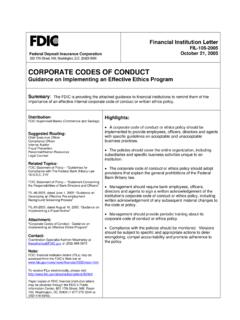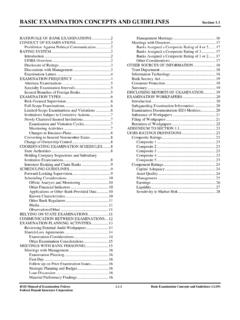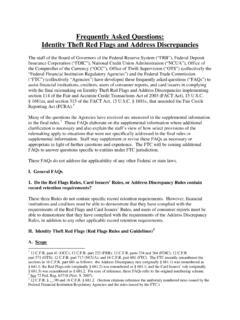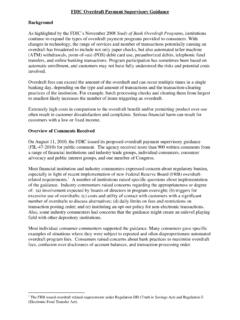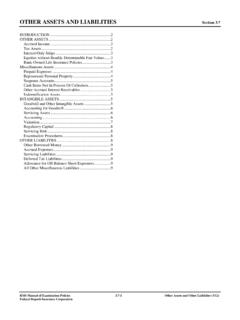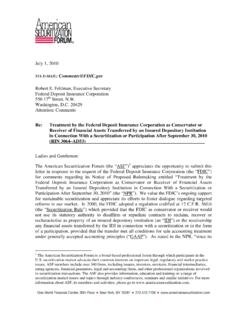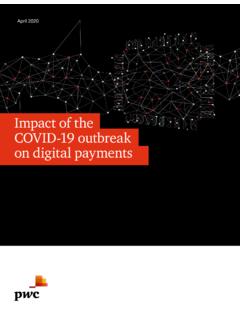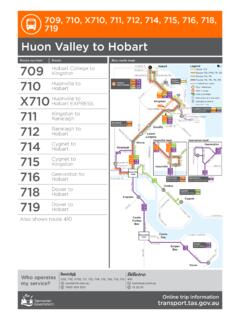Transcription of II. CREDIT CARDS – GENERAL OVERVIEW
1 Risk Management Examination Manual of CREDIT Card Activities Chapter II II. CREDIT CARDS GENERAL OVERVIEW WHAT IS A CREDIT CARD In its non-physical form, a CREDIT card represents a payment mechanism which facilitates both consumer and commercial business transactions, including purchases and cash advances. A CREDIT card generally operates as a substitute for cash or a check and most often provides an unsecured revolving line of CREDIT . The borrower is required to pay at least part of the card s outstanding balance each billing cycle, depending on the terms as set forth in the cardholder agreement. As the debt reduces, the available CREDIT increases for accounts in good standing. These complex financial arrangements have ever-shifting terms and prices.
2 A charge card differs from a CREDIT card in that the charge card must be paid in full each month. In physical form, a CREDIT card traditionally is a thin, rectangular plastic card. The front of the card contains a series of numbers that are representative of various items such as the applicable network, bank, and account. These numbers are generally referred to in aggregate as the account number or card number. A magnetic stripe, often called a magstripe, runs across the back of the card and contains some of the account s information electronically. The back of the card also contains a cardholder signature box. There are many other physical attributes to a CREDIT card; however, as technologies progress, their physical form is morphing. For example, multi-application CARDS (sometimes referred to as smart CARDS ) involve aspects of cryptography (secret codes) and, in place of the magstripe, have a microprocessor, or chip, built into the card.
3 The enhanced memory and processing capacity greatly exceeds that of the traditional magstripe card, and the multi-application CARDS can enable consumers to access several financial accounts and other services or data (like merchant loyalty programs) with a single card. Emerging formats also include contactless and biometric payment options. With the contactless payment format, CARDS are tapped on readers (instead of swiped) at the point-of-sale. This format is also known as proximity, tap n go, or blink technology. The biometric format relies on a cardholder s physical or biological features by using identification techniques like fingerprint verification, iris scans, or voice scans. Electronic payment innovations may well be only in their infancy. INDUSTRY HISTORY The CREDIT card lending business experiences rapid change, but not just in the technology environment.
4 New competitors continue to emerge from not only the banking industry, but from phone companies, retailers and others. At the same time, consolidation among CREDIT card issuers has also increased. For example, during a four-month period in 2005, the three largest monoline CREDIT card banks (MBNA, Capital One Financial Corporation, and Providian) all announced some type of acquisition The CREDIT card industry s focus has shifted from prestige to merchant acceptance to pricing and perks. Intense competition, market saturation, and changing consumer postures have forced issuers to be innovative with the CREDIT card products offered and to develop sophisticated customer selection and management methods. Processes have evolved to risk ranking applicants and pricing each account accordingly. Risk-based pricing has allowed banks to issue CARDS to less-qualified applicants in exchange for a higher interest rate or other fees and to essentially offer customized card products.
5 Rewards programs are extremely popular, and CREDIT CARDS can now be used to purchase items in well over 100 currencies. 1 According to an article entitled OVERVIEW of Recent Developments in the CREDIT Card Industry found in the November 2005 issue of the FDIC Banking Review and authored by Douglas Akers, Jay Golter, Brian Lamm, and Martha Solt. March 2007 FDIC- Division of Supervision and Consumer Protection 10 CREDIT CARDS GENERAL OVERVIEW Visa and MasterCard (together referred to as Associations) quickly come to mind when the term CREDIT card is used. Traditionally banks purchased memberships in the Associations, and, in return, receive the right to offer CREDIT card products or other services under the applicable Association s In addition to operating worldwide sophisticated payment networks, the Associations provide services including, but not limited to, advertising, statistical analysis, industry studies, and advisory services.
6 They require their member banks to be insured and to operate within certain policies. The Associations do not issue CARDS or financial services directly to consumers or merchants. Rather, they focus on advancing payment products and technologies for their member banks, and the member banks manage the relationships with consumers and merchants. The Associations offer various membership grades, which can be subject to certain requirements, such as capital levels or acceptable growth projections. While the Associations remain the prominent brands in the bank CREDIT card industry, other brands, such as American Express and Discover, are challenging their share. Unlike the Associations, American Express and Discover traditionally both issued their own CARDS . While they have long been in the CREDIT card business, they only recently expanded their access within the bank CREDIT card business as a result of court rulings in 2004.
7 Those rulings said that the Associations policies barring member banks from contracting with American Express and Discover violated antitrust rules. The rulings have not only resulted in some Visa and MasterCard banks now also offering American Express and /or Discover CARDS , but are also leading to dual-branding. For simplicity, MasterCard, Visa, American Express, and Discover are collectively referred to as Networks in this manual. The term Networks is used because these companies interconnect a large and widely-distributed group of people and entities to communicate with one another and work together as a system to facilitate card transactions. The system allows for the routing of a transaction s information between the participants in a matter of fractions of a second. Payment systems for CREDIT CARDS are discussed in Chapter XIX, Merchant Processing.
8 The legal and regulatory environment for the bank CREDIT card industry continues to shape the industry as well. For instance, in the 1970 s, the Supreme Court ruled that the lender s location, not the consumer s state of residence, determined the applicable state usury ceiling. As a result, large card issuers have sought out states with lender-friendly usury ceilings in which to establish national operations. For example, several bank CREDIT card operations are located in South Dakota and Delaware. The 1970 s also saw Congress enact a number of consumer CREDIT protection laws. More recent banking regulatory developments include the issuance of subprime lending guidance in 1999 and 2001 and account management and loss allowance guidance in Concepts from these documents are discussed throughout this manual. CARD TYPES AND ATTRIBUTES A multitude of CREDIT card products are available to consumers, and the number of products is growing.
9 Terms and conditions of each CREDIT card product offered, such as the Annual Percentage Rate (APR), the monthly minimum payment formula, and certain fees, are detailed in a cardholder agreement which is required by regulation. The following sections provide an OVERVIEW of some common CREDIT card product categories. 2 MasterCard became a private, SEC-registered share company whose shares were owned by the principal members of MasterCard International in 2002, and in May 2006 it announced an initial public offering and began trading on the New York Stock Exchange under the symbol MA. 3 March 1, 1999 Interagency Guidance on Subprime Lending (FIL-20-99); January 31, 2001 DSC Memorandum Transmittal Number 01-005 Expanded Guidance for Evaluating Subprime Lending Guidance (FIL-9-2001); and January 8, 2003 Account Management and Loss Allowance Guidance for CREDIT Card Lending (FIL-2-2003).
10 March 2007 FDIC Division of Supervision and Consumer Protection 11 Risk Management Examination Manual of CREDIT Card Activities Chapter II GENERAL Purpose CREDIT CARDS GENERAL purpose, or universal, CREDIT CARDS can be used at a variety of stores and businesses. They take on many forms, including standard, premium, affinity, co-branded, corporate, home equity, and cash secured programs, each of which is briefly described next. Standard CREDIT Card Programs: Standard CREDIT card programs are a traditional form of CREDIT card issuance. These programs are usually marketed to consumers who meet or exceed the institution s minimum CREDIT criteria but that may lack sufficient CREDIT history or may fail to meet some of the institution s other CREDIT criteria.
